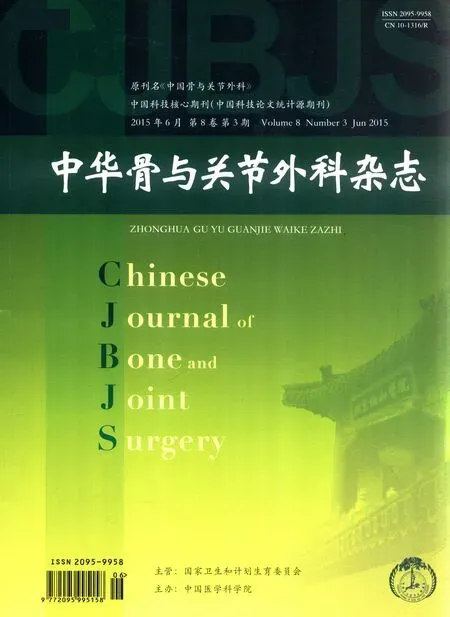胸腰椎骨质疏松性骨折后骨不连的治疗进展
2015-01-21李厚坤郝定均王敏钱冰李汉王刚
李厚坤 郝定均王敏 钱冰 李汉 王刚
(西安市红会医院脊柱外科,西安710054)
胸腰椎骨质疏松性骨折后骨不连的治疗进展
李厚坤 郝定均*王敏 钱冰 李汉 王刚
(西安市红会医院脊柱外科,西安710054)
随着中国进入老龄化时代,骨质疏松症患者越来越多,对40岁以上的汉族人群调查结果显示,骨质疏松症的患病率可达12.4%[1]。骨质疏松症患者易发生骨折,发生于椎体的骨折叫骨质疏松性椎体压缩性骨折(osteoporotic vertral compression fracture,OVCF)。对于整个脊柱而言,OVCF多见于胸腰段,此处应力集中,活动度大,在原发疾病的基础上可发生骨质疏松性椎体骨折后骨不连[2]。骨质疏松性椎体骨折后骨不连也叫kümmel病,德国医师kümmel于1895年首次描述该病的发病过程[3],其病程起始一般为一次微小的脊柱创伤,紧随其后的数周乃至数月几乎无任何症状,但随后又表现出临床症状,并进一步加重出现后凸畸形[4,5]。诊断该病最主要的特征是裂隙征[6-10]。影像学技术的发展促进了骨质疏松性椎体骨折后骨不连的诊断和治疗。本文对胸腰椎骨质疏松性骨折后骨不连的治疗现状及进展做一综述。
1 胸腰椎骨质疏松性骨折后骨不连的诊断
胸腰椎骨质疏松性骨折后骨不连的发展过程主要有3个阶段:①脊柱椎体未受创伤或者受到轻微创伤;②椎体在裂缝处出现动态不稳定进而出现骨折塌陷;③椎体压缩性骨折在后方形成占位,压迫脊髓导致持续的后背痛和神经症状[11]。
胸腰椎骨质疏松性骨折后骨不连这一诊断名词是由M aldague等[6]首次使用。其影像学特征为椎体内空气征。随着影像学技术的发展,复杂性胸腰椎骨质疏松性骨折后骨不连的诊断技术有了进一步的发展[12]。最早的普通侧位X线片的确诊率仅为14%,而MRI的确诊率可达96%[13]。骨质疏松性骨折后骨不连在MRIT2加权像为高信号[15]。裂隙征在对比增强MRI中表现出的未增强区域即为椎体内裂隙的形状[16]。形成这种信号的原因可能是由于椎体骨折后气体从软骨下裂缝中释放后形成的气体征。充气裂隙随后又充满了液体,继而形成MRI的特征性表现[17]。术中取活检后行组织学分析,裂隙中充满了浆液和坏死的肉芽组织[18]。Toyone等[19]研究发现新鲜的椎体骨折没有裂隙,裂隙是逐渐发展而形成的。病理学检查是诊断此类疾病的金标准,当椎体空腔内出现死骨和纤维增生改变,该病即可确诊[21]。
Tsujio等[22]报道了椎体骨折行6个月保守治疗后骨不连的发生率为13.5%。胸腰椎骨折、中柱损伤和椎体骨折在MRIT2加权像表现出低密度,均为椎体骨不连的危险因素。临床中该病表现出的特征为渐进的椎体塌陷和力学不稳定性,最后发展为进行性的后凸畸形伴持续的后背部疼痛和下肢神经症状[23,24]。
2 胸腰椎骨质疏松性骨折后骨不连的治疗
随着对胸腰椎骨质疏松性骨折后骨不连认识的不断深入,其治疗方式也越来越多样化。临床中应用较多的有以下几种治疗方法:开放手术治疗、经皮椎体成形术(PVP)、经皮椎体后凸成形术(PKP)。手术治疗的目的是减轻后背疼痛,进一步预防椎体塌陷,从而阻止后凸畸形的形成。
2.1 开放手术
骨质疏松性椎体骨折后骨不连经常被忽视而未作治疗。此类患者通过卧床休息、麻醉止痛剂、支具固定等保守疗法往往效果甚微。Li等[25]报道了21例使用短节段固定治疗有脊髓压迫的kümmel病取得了很好的临床效果。同时,传统的开放手术面临挑战。内置物在骨质疏松的椎体中很难具有把持力,效果往往不好[5]。此外,一些老年患者不能承受开放手术的创伤,这也是无神经损伤性椎体骨折后骨不连的相对禁忌证。
2.2 PVP PVP
PVP对于胸腰椎骨质疏松性骨折后骨不连患者在疼痛减轻和恢复后凸畸形方面有着重要的作用[26]。有研究表明,有骨不连病史的患者在疼痛减轻程度和日常生活能力方面均差于无骨不连病史的患者。对患者进行随访后发现,后凸畸形的矫正和高度的恢复情况有再次加重的可能[27,28]。Garfin等[29]认为经过PVP治疗,裂隙没有得到充分修复,导致临床治疗的失败。同时骨水泥渗漏的比例高是PVP治疗胸腰
椎骨质疏松性骨折后骨不连的又一并发症。Ha等[27]报道了PVP治疗椎体压缩性骨折后骨不连骨水泥渗漏率为75%。Jung等[30]报道治疗椎体压缩性骨折后骨不连患者的骨水泥渗漏率为55.5%。按渗漏至部位来分类,椎间盘为65.0%、椎体周围静脉为25%、硬膜外为5%、神经孔为5%。PVP出现如此高的骨水泥渗漏率可能有两个原因:①骨水泥从椎体裂隙漏出;②骨水泥粘性不足。
2.3 PKP PKP
根据较早的文献报道,PKP是由PVP发展而来,其治疗骨质疏松性椎体骨折后骨不连有更多的优势。PKP已被证实在后凸畸形的矫正和防止骨水泥渗漏方面有很好的效果。球囊扩张裂隙后可以注射更多粘性骨水泥,从而堵塞通向椎体外壁的出口[31-33]。Lane等[18]报道PKP术后患者疼痛明显减轻,并主张使用聚甲基丙烯酸甲酯(PMMA)骨水泥,可均匀分散在椎体裂隙中,从而最大限度提高椎体的稳定性。周英杰等[23]报道了59例胸腰椎椎体骨折患者,分别采用PMMA和Confidence高黏度骨水泥行椎体成形术,结论认为两种骨水泥有相近的临床疗效。
Wang等[23]报道27例骨质疏松性骨折后骨不连患者行PVP术后疼痛减轻和伤椎稳定性提高效果良好。Yang等[34]报道21例胸腰椎骨质疏松性骨折后骨不连患者使用改良后PKP,后背部疼痛减轻,丢失高度恢复,后凸畸形得到矫正。此外,19例创伤所致骨质疏松性骨折后骨不连患者使用PKP得到了相似的效果[35]。Yang等[36]报道21例骨质疏松性椎体压缩性骨折后骨不连的患者,PKP术后随访结果示Cobb角度恢复良好、疼痛减轻和功能障碍指数得到改善。
PKP骨水泥的渗漏率低于PVP。Wang等[23]认为有裂隙的椎体压缩性骨折在术前应当使用CT进行评估,以确定裂隙的具体位置以及裂隙有没有突破椎体外壁。有研究报道了一些防止骨水泥渗漏的方法[30,31,37]。高粘度的PMMA骨水泥可以有效防止骨水泥的渗漏[31]。Gan等[38]也报道了有关防止骨水泥前壁渗漏的方法,首先用小剂量处于面团期中期或者后期骨水泥注入骨不连部位通入前壁的地方,用来防止椎体前缘的渗漏。当骨水泥凝固后,再使用拉丝期骨水泥的后期或者面团状期骨水泥的前期用来均匀弥散裂隙内。对于椎体后壁损伤的患者,在持续透视监视下,当骨水泥达到椎体侧缘或者距离椎体后壁1/4的距离时终止注射骨水泥[39]。对于外侧壁损伤的患者,扩大椎间隙,移除球囊,后用1m l的粘性骨水泥填充破损外侧壁,随后球囊再次插入裂隙中使骨水泥再次填充周围间隙,使周围的骨水泥均匀弥散整个椎体[40]。此外,骨质疏松性骨折后骨不连经常导致严重的椎体压缩。过度的球囊扩张可以引起椎体发生扩张,增加了骨水泥渗漏的风险[35]。杨惠光等[41]报道了7例骨质疏松性椎体骨折后骨不连的患者通过PKP治疗的术后疗效满意。王根林等[42]报道39例骨质疏松性骨折后骨不连患者行PKP治疗,术后平均随访26.3个月恢复良好,结论认为PKP这种术式具有创伤小,安全有效等优点。
3 展望
胸腰椎骨质疏松性椎体骨折后骨不连的病因受多因素影响,其机制仍不是很清楚。保守治疗往往效果不佳,一般需要手术干预。目前,PVP、PKP两种安全有效的术式为多数临床医师所青睐,其远期效果还需要进一步观察研究。
[1]黄公怡.骨质疏松性骨折及治疗原则.国外医学内分泌学分册,2003,23(2):111-113.
[2]Pappou IP,Papadopoulos EC,Sw anson AN,etal.Osteo-porotic vertebral fractures and collapse w ith int-ravertebral vacuum sign(Kummell′s disease).Orthopedics,2008,31(1): 61-66.
[3]Kummell H.Die rarefizierendeOstitis der Wirbel-korper. DeutscheMed,1895,21:180-181.
[4]Benedek TG,Nicholas JJ.Delayed traumatic verte-bral body compression fracture;partⅡ:patholo-gic features. Sem in ArthritisRheum,1981,10(4):271-277.
[5]Swartz K,Fee D.Kummell's disease:a case reportand literature review.Spine,2008,33(5):E152-155.
[6]Maldague BE,Noel HM,Malghem JJ.The intrave-rtebral vacuum cleft:a sign of ischemic vertebral collapse.Radiology,1978,129(1):23-29.
[7]Golimbu C,Firooznia H,RafiiM.The intraver-tebral vacuum sign.Spine,1986,11(10):1040-1043.
[8]LibicherM,AppeltA,Berger I,etal.The intra-vertebral vacuum phenomena as specific sign of osteonecrosis in vertebral compression fractures:results from a radiological and histologicalstudy.Eur Radiol,2007,17(9):2248-2252.
[9]Bhalla S,Reinus WR.The linear intravertebral vacuum:a sign of benign vertebral collapse.Am JRoentgenol,1998, 170(6):1563-1569.
[10]Theodorou DJ.The intravertebralvacuum cleftsign.Radiol-
ogy,2001,221(3):787-788.
[11]Ito Y,Hasegaw a Y,Toda K,et al.Pathogenesis and diagnosis of delayed vertebral collapse resu-lting from osteoporotic spinal fracture.Spine J,2002,2(2):101-106.
[12]Stäbler A,Schneider P,Link TM,et al.Intra-vertebral vacuum phenomenon following fractures:CT study on frequency and etiology.JComputAssist Tomogr,1999,23(6):976-980.
[13]McKiernan F,FaciszewskiT.The intravertebral clefts in osteoporotic vertebral compression fractures.Arthritis Rheum, 2003,48(5):1414-1419.
[14]PehWC,GelbartMS,Gilula LA,etal.Percutaneous vertebroplasty:treatment of painful vertebral compression fractures w ith intraosseous vacuum phenomena.AJR Am J Roentgenol,2003,180(5):1411-1417.
[15]Naul LG,Peet GJ,Maupin WB.Avascular necrosis of the vertebral body:MR imaging.Radiology,1989,172(1):219-222.
[16]Oka M,MasakiM,Nobuo K,etal.Intravertebral cleft sign on fat-suppressed contrast-enhanced MR:correlation with cement distribution pattern on percutaneous vertebroplasty. Acad Radiol,2005,12(8):992-999.
[17]BaurA,StablerA,Arbogast S,etal.Acute osteoporotic and neoplastic vertebral com pre-ssion fractures:fluid sign at MR imaging.Radiology,2002,225(3):730-735.
[18]Hasegawa K,Homma T,Uchiyama S,etal.Vertebralpseudarthrosisin the osteoporotic spine.Spine,1998,23(22): 2201-2206.
[19]Toyone T,Tanaka T,Wada Y,et al.Changes in vertebral wedging rate between supine and standing position and its association w ith back pain:a prospective study in patients with osteoporotic vertebral compression fractures.Spine, 2006,31(25):2963-2966.
[20]周英杰,赵鹏飞,郑怀亮,等.两种骨水泥应用于老年胸腰椎骨折椎体成形术的疗效观察.中国矫形外科杂志, 2015,23(4):364-367.
[21]Maldague BE,Noel HM,M alghem JJ.The intraver-tebral vacuum cleft:a sign of ischem ic vertebracollapse.Radiology,1978,129(1):23-29.
[22]Tsujio T,Nakamura H,Terai H,et al.Characteristic radiographic ormagnetic resonance images of fresh osteoporotic vertebral fractures predicting potential risk for nonunion:a prospectivemulticenter study.Spine(Phila Pa 1976),2011, 36(15):1229-1235.
[23]Wang G,Yang H,Chen K.Osteoporotic vertebral compression fracturesw ith an intravertebral cleft treated by percutaneous balloon kyphop lasty.J Bone Joint Surg Br,2010,92 (11):1553-1557.
[24]Yang HL,Wang GL,Niu GQ,et al.Using MRI to determ ine painful vertebrae to be treated by kyphoplasty inmultiple-level vertebral compression fractures:a prospective study.JIntMed Res,2008,36(5):1056-1063.
[25]LiKC,LiAF,Hsieh CH,etal.Another option to treat Kummell’sdiseasew ith cord compression.Eur Spine J,2007,16 (9):1479-1487.
[26]Grohs JG,MatznerM,Trieb K,et al.Treatment of intravertebral pseudarthroses by balloon kyphoplasty.JSpinal Disord Tech,2006,19(8):560-565.
[27]Ha KY,Lee JS,Kim KW,etal.Percutaneousvertebroplasty for vertebral compression fractures with and w ithout intravertebral clefts.JBone JointSurg Br,2006,88(5):629-633.
[28]M cKiernan F,Jensen R,FaciszewskiT.The dynam icmobility of vertebral compression fractures.J Bone M in Res, 2003,18(1):24-29.
[29]Garfin SR,Yuan HA,Reiley MA.New technologies in spine:kyphop lasty and vertebroplasty for the treatment of painful osteoporotic compression fractures.Spine,2001,26 (14):1511-1515.
[30]Jung JY,Lee MH,Ahn JM.Leakage of polymethylmethacrylate in percutaneous verteb-roplasty:comparison of osteoporotic vertebral compression fracturesw ith and w ithout an intravertebral vacuum cleft.JComput Assist Tomogr,2006, 30(3):501-506.
[31]Chen L,Yang H,Tang T.Unilateral versus bilateral balloon kyphoplasty formultilevel osteoporotic vertebral compression fractures:a prospective study.Spine(Phila Pa 1976), 2011,36(7):534-540.
[32]Zhang HT,Sun ZY,Zhu XY,etal.Kyphoplasty for the treatmentof very severe osteoporotic vertebral com pression fracture.JIntMed Res,2012,40(6):2394-2400.
[33]Shen M,Wang H,Chen G,etal.Factors affecting kyphotic angle reduction in osteoporotic verte-bral compression fracturesw ith kyphoplasty.Orthopedics,2013,36(4):E509-514. [34]Yang H,Gan M,Zou J,etal.Kyphoplasty for the treatment of Kummell’s disease.Orthopedics,2010,33(7):479.
[35]Wang G,Yang H,Meng B,etal.Post-traumatic osteoporotic vertebral osteonecrosis treated using balloon kyphoplasty. JClin Neurosci,2011,18(5):664-668.
[36]Yang H,Wang G,Liu J,et al.Balloon kyphoplasty in the treatment of osteoporotic vertebral compression fracture nonunion.Orthopedics,2010,33(1):24.
[37]Qian Z,Sun Z,Yang H,etal.Kyphoplasty for the treatment ofmalignant vertebral compression fractures caused bymetastases.JClin Neurosci,2011,18(6):763-767.
[38]Gan M,Yang H,Zhou F,et al.Kyphoplasty for the treatment of painful osteoporotic thoracolumbar burst fractures. Orthopedics,2010,33(2):88-92.
[39]Yang H,Pan J,Sun Z,etal.Percutaneousaugmented instrumentation of unstable thoracol-umbar burst fractures:our experience in preven-ting cement leakage.Eur Spine J, 2012,21(7):1410-1412.
[40]Zou J,Mei X,Gan M,et al.Is kyphoplasty reliable for osteoporotic vertebral compression fracture with vertebral w all deficiency?Injury,2010,41(4):360-364.
[41]杨惠光,刘勇,张云庆,等.骨质疏松性椎体骨折后骨坏死的诊断和治疗.中国脊柱脊髓杂志,2012,22(4):379-380.
[42]王根林,杨惠林,朱雪松,等.骨质疏松性椎体骨坏死的诊断和治疗.中国脊柱脊髓杂志,2013,2(3):228-232.
2095-9958(2015)06-0 278-03
10.3969/j.issn.2095-9958.2015.03-020
*通信作者:郝定均,E-mail:haodingjun@126.com
